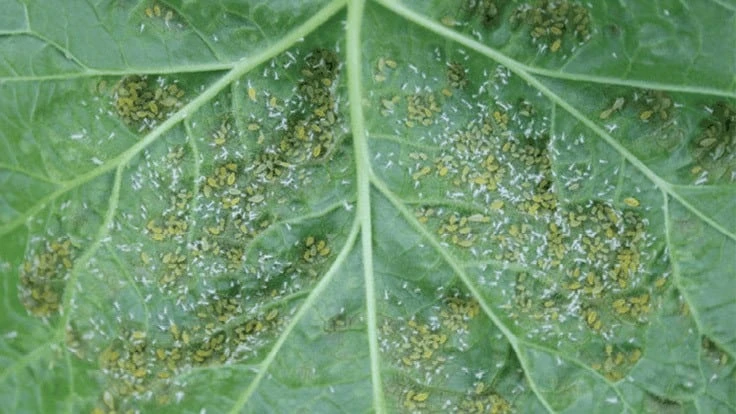
_fmt.png)
Pesticides (insecticides, miticides, fungicides and bactericides) are used to manage arthropod (insect and mite) pests and diseases (fungi and bacteria) in greenhouse production systems. Pesticides, in general, are easy and convenient to apply, and effective in terms of control, suppression or management. There are several factors related to greenhouses that favor pest population growth including environment (e.g., temperature, relative humidity and photoperiod); cultural practices (e.g., watering and fertility); and plants provide a continuous food source (many plants grown in the greenhouse and spaced close together). Consequently, greenhouse producers routinely apply pesticides to prevent or minimize plant damage. However, continually relying on pesticides promotes the development of resistance in arthropod pests and plant pathogen populations.
This is the fifth article in a series of six scheduled for publication in Greenhouse Management associated with pesticide resistance and resistance management of arthropod pests and diseases. Three articles were published in 2019 and the fourth article was published in the 2020 March issue of Greenhouse Management. In this article, we discuss how pesticide mixtures may help in resistance management.
Arthropod pests
A pesticide mixture is associated with mixing (tank-mixing) or combining two or more pesticides (in this case, insecticides and/or miticides) into a single spray solution. The mixture, when applied to greenhouse-grown horticultural crops, exposes individuals in an arthropod-pest population to each pesticide simultaneously. The mixing of pesticides together is designed to manage multiple concurrent insect and mite pests, and reduce labor.
So, how can pesticide mixtures be used in resistance management programs? The issue of pesticide mixtures and resistance management is not well understood. In fact, applying two or more pesticides at different intervals is thought to have the same advantages as a pesticide mixture. However, this is not correct; each individual insect or mite in a population has not been exposed to a lethal dose or concentration of each pesticide. Consequently, resistance can evolve more rapidly than what might occur with a pesticide mixture. Therefore, mixing pesticides with different modes of action (MOAs) can delay resistance within an arthropod-pest population because the mechanism(s) required to resist the pesticide mixture (e.g., metabolic detoxification or target site insensitivity) may not be widespread or present throughout the arthropod pest population. Furthermore, it may be more difficult for individuals in the arthropod-pest population to develop resistance to several MOAs simultaneously. In addition, individuals in the population resistant to one or more pesticides in all likelihood would succumb to the other pesticide in the mixture, as long as agents with different MOAs are mixed together.
Pesticide mixtures may be helpful for mitigating the potential for resistance developing in an arthropod-pest population. For instance, developing pesticide mixtures that include agents with site-specific (narrow-spectrum) MOAs with pesticides that have non-specific (broad-spectrum) MOAs such as insecticidal soap, horticultural oils, and beneficial fungi and bacteria, may mitigate the development of resistance. Tank-mixing pesticides with different but specific MOAs can potentially lead to multiple resistance or resistance to two different pesticides, although this depends on the specific insect or mite pest.
It is important to note that continued use of the same pesticide mixtures in succession may result in resistance developing in an arthropod-pest population to both modes of activity. Therefore, greenhouse producers must use different products with distinct MOAs to mitigate the potential for resistance. Insect and mite pest populations that have acquired resistance to two different pesticides with different modes of activity are extremely difficult to manage, which will limit pesticide options.
The effects of pesticide mixtures on arthropod-pest populations can vary depending on differences related to species, strain and biotype associated with physiology and the resistance mechanisms present in the population. Moreover, using pesticide mixtures to avoid resistance will only be successful if there is no cross-resistance among individuals in the pest population (based on a single resistance mechanism that confers resistance to pesticides in the same chemical class and/or having similar MOAs) to any of the pesticides in the mixture.
_fmt.png)
_fmt.png)
Plant pathogens
The use of pesticide mixtures (tank mixes) to reduce the possibility of resistance developing in fungal and bacterial plant pathogen populations is well established in ornamental disease control. In the early days, research associated with large-scale agriculture demonstrated equal benefits from using pesticide mixtures or rotating products to mitigate resistance developing in disease-causing agents. We have moved from relatively few broad-spectrum products that were available in the early 1980s to at least 10 times the number of products. Consequently, the question of tank-mixing has taken on a new meaning. Many products from the 80’s had broad and multiple effects on plant pathogens, making development of resistance less likely. In the early 1980s, several large agrichemical companies got together and started the Fungicide Resistance Action Committee (FRAC), with the purpose of providing fungicide-resistance-management guidelines to “prolong the effectiveness of at risk fungicides and reduce crop losses should resistance occur.” Today, products are much more environmentally safe and have targeted MOAs representing more than 30 different FRAC groups; thus making tank-mixing very targeted but quite complex.
The reason tank-mixing works in our industry is due to the complexity of our product mix and the fact that we have overlapping crop cycles in our operations, which results in the need to protect crops from damage. Prevention is much more important for ornamental crops than agricultural ones such as vegetables, fruits and grains where only a portion of the plant is harvested. Furthermore, we have to focus on certain market targets, which means that delaying crop regrowth can mean a loss of the market window, and therefore a loss in profits.
The mixing of pesticides together is designed to manage multiple concurrent insect and mite pests, and reduce labor.
Tank-mixing for resistance management is really secondary to tank-mixing for disease management. The difficult part of disease control is knowing what the problem is. For example, most plant diseases cannot be visually diagnosed, and by the time one observes disease symptoms, damage may not be reversible. So, prevention with pesticide mixtures is often practiced.
The theories associated with pesticide mixtures or tank-mixing for resistance management in plant pathology are changing. For instance, I listened to a series of talks at our plant-pathology annual meeting last summer; researchers proved that tank-mixing two different groups of fungicides to delay resistance development to one fungicide was not working in Europe.
One of the developments that may help in mitigating resistance development is using biopesticides. Many of these agents have multiple MOAs, including excluding the plant pathogen by taking up space where a plant pathogen might reside, acting as a barrier between the plant and plant pathogen (this is usually accomplished by living organisms such as Bacillus, Ulocladium and Trichoderma), parasitizing plant pathogens, creating an environment that is inhospitable to a plant pathogens, and causing plants to use disease-fighting mechanisms against the plant pathogen. Consequently, there are many factors working against the plant pathogen, which makes resistance development less likely. So, for biopesticides, rotating products may be preferable to using pesticide mixtures as a means of resistance management.

Explore the June 2020 Issue
Check out more from this issue and find your next story to read.
Latest from Greenhouse Management
- Grant awarded to test western U.S. wood species for use as wood fiber potting substrate
- Pennsylvania Horticultural Society announces 2025 Gold Medal Plant winners
- GIE Media Horticulture Group wins five regional 2025 Azbee Awards of Excellence
- Terra Nova Nurseries introduces rust-free and disease-resistant heucherella
- John T. Nickel, founder of Greenleaf Nursery Co., passes away at 89
- Three tours offered at 2025 Farwest Show
- Garden Media Group announces sixth annual Women in Horticulture Week
- Star Roses and Plants announces National Knock Out Rose Day





